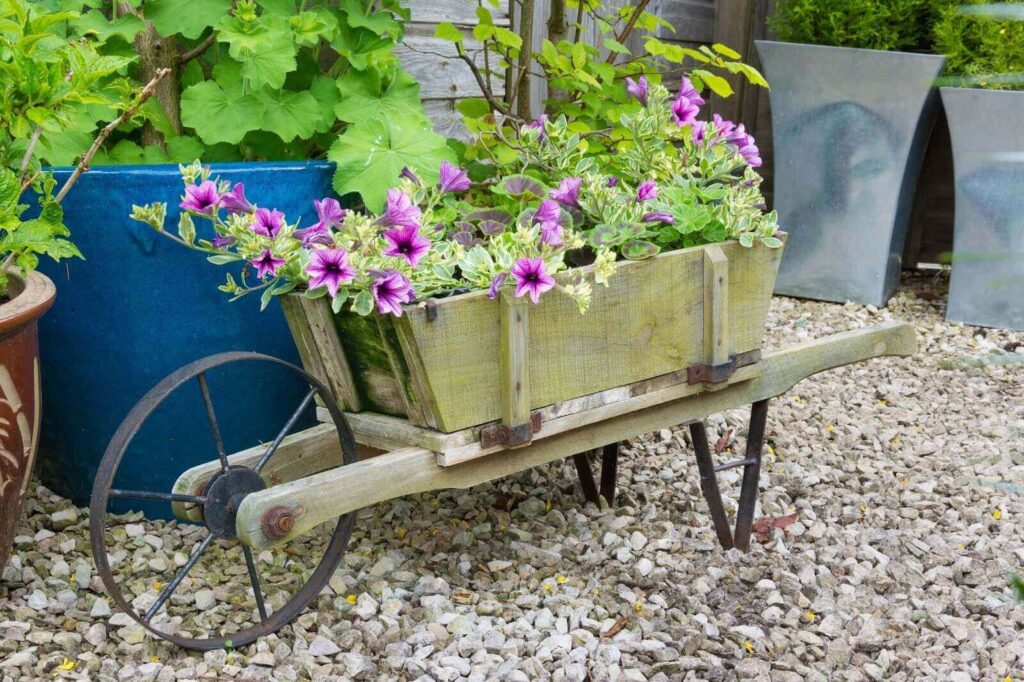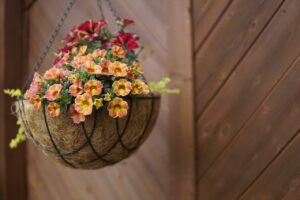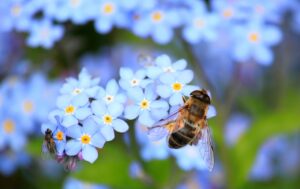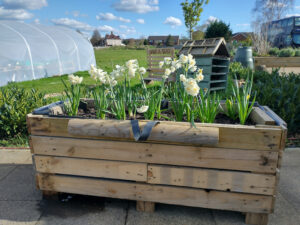
Anyone can make improvements to their gardens to make them more eco-friendly and now more than ever, we should be doing as much as possible! There are plenty of ways you can make adjustments without having to go above and beyond, and without having to spend lots of money. Below are only a few of the amazing ways you can turn your garden into an eco-friendly garden!
7 Easy, Environmentally Friendly Eco Garden Ideas
Up-Cycle Garden Furniture

When the weather is getting nicer, and you’re spending more time in your garden, it can be tempting to want to get new garden furniture to change up your space. However, why not find something you don’t use anymore and maybe give it a lick of paint?
This way, you get to give it a new lease of life and make it feel brand new. For example, an old wheelbarrow can be turned into a rustic planter to showcase some colourful flowers with just a little bit of paint and imagination.
This way, you’re saving money and being more eco-friendly while acquiring a lovely new garden feature. If you don’t have anything yourself, then why not look online for pre-loved items or helpful recycled materials? By visiting online selling spots such as Ebay and Facebook Marketplace, you’re likely to find something easily salvageable for a fraction of the price. You could even pop into some local charity shops and support your community at the same time.
Choose Eco-Friendly Plants
It’s important to choose the best garden plants that will provide shelter and food for wildlife for your eco garden. The right plants can create little habitats for insects and birds.
Local berry-producing trees and plants that might be growing in your area are perfect as the creatures around will already be used to them, so it will give them more places to source them and visit you more often. Using native plants to your area is a key step in ensuring the ecosystem surrounding your local area is kept well balanced.
If you need to do some regular ‘weed-control’, we recommend using an eco-friendly weed killer to do the job, making a ‘dish-soap-solution’, or simply removing the offending weeds by hand. Killing weeds is an essential part of keeping your garden looking as lovely as possible, so when you do it, it’s important to keep in mind the rest of your plants and root systems.
Try filling a spray bottle with either organic herbicides, an organic weed killer or an environmentally friendly weed killer and using it sparingly on your weeds.
Make Your Own Compost
Making your own compost and compost heaps is so simple to do with things that would normally go to waste like grass clippings and vegetable peelings, and over time, it will all decompose and turn into compost.
You can get a compost bin and put in your garden somewhere out of the way and you won’t even notice it, although make sure the spot isn’t too shady as the heat is a key component for composting. The heat will kill any potential weeds and form compost quicker.
There are so many things you can add to your compost, including lawn clippings, hedge trimmings, tea bags, leaves, egg boxes, and cardboard. If you’d like to sterilize your compost, we suggest pouring boiling water over it. Sterilizing compost is recommended for those who want to use it as potting mix, as sometimes the state it starts in isn’t beneficial to the most healthy seed growth.
Make Homes For Wildlife
Sometimes wildlife can do with an extra helping hand with their homes. Providing bird boxes and places for creatures to shelter is a perfect way to help and attract wildlife to your area. There are plenty of ways you can make wildlife comfortable in your garden and you don’t even need to spend any money because you can make your own!
For the more timid or nocturnal animals like hedgehogs, be sure to find a quiet little spot, out of direct sunlight and wind to create the perfect environment for them to seek refuge and relax. Also make sure to provide water and food to welcome them upon arrival!
Grow Your Own Vegetables
Growing your own fruit and vegetables is a perfect way to help the environment as well as save money! You’ll notice on the labels of supermarket produce that they, more often than not, would’ve had to travel from all over the world to get there, which is of course damaging for the environment. If you don’t know where to start when it comes to creating a vegetable garden, then we’re here to help.
However, growing your own means they would just have to travel the short distance from your garden to your kitchen, and you’ll find that home-grown tastes so much better! It’s also a fantastic way to bridge the gap between neighbours or those around you, by offering your home-grown goodies to people who might enjoy them.
Collect Rainwater
Now more than ever, it’s important to save water to help our environment and save energy. The process of getting water to your homes involves energy which is needed to filter, heat and pump the water. Using less water means that there will be more in our ecosystems to help the animals’ habitats. Installing a water feature in your garden is also a great way to reuse water and create a space for certain creatures to drink and bathe in peace.
A way you can reduce water when it comes to your garden is by purchasing a water butt. The water butt collects rainwater and stores it so that you can use it particularly in the warmer weather when we might not get much rain.
Your plants and vegetables will need plenty of water to stay hydrated in this weather, so a water butt is a perfect way to keep them alive and save water as you won’t be needing to use water from the mains of your house. This is also an effective way to reduce your carbon footprint.
Improve Access For Wildlife
Long before they were our gardens, they were the homes of plenty of wildlife. It’s important that we still allow wildlife to have a home making them easily accessible for all sorts of creatures. The way that modern gardens are being designed with enclosed walls and fences make it difficult for wildlife to access.
Making small adjustments will make a massive difference for the lives of animals like hedgehogs. Cutting a small hole in the bottom of your fence means that creatures of all kinds will be able to find a home. For example, hedgehogs only need a gap of around 13 cm by 13 cm!



